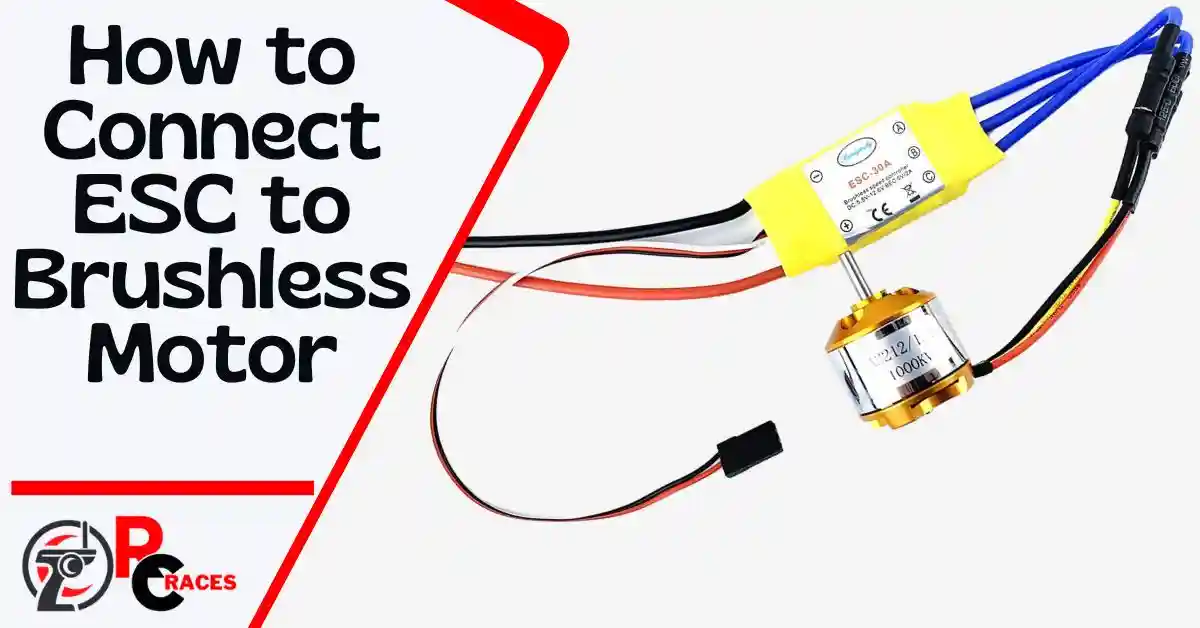Introduction
Having trouble connecting your brushless motor to the ESC?
Well, you’re not the only one. Most RC hobbyists suffer from the same issue when they start out. As frustrating as the problem is, the solution is fast and easy.
So you must be wondering how to connect ESC to a brushless motor?
There are two ways of connecting ESC to a brushless motor. Connect the motor wires to ESC in any order for a sensorless motor. However, for a sensored motor, connect them according to their markings (A, B, C) or color coding. To alternate the motor spin, switch the outer and center wire.
Right from the get-go, you know how to make the connection. Now to delve deeper into the issue, stay with me through the rest of the article.
Phase 1: Brainstorming
Most brushless ESCs generally work with brushless motors. However, there are cases where an ESC may get too hot with a motor. You can ensure the compatibility of the ESC and the motor through a simple calculation.
Step 1: Calculating ESC for Brushless Motor
Calculating ESC requires us to know the motor amperage. To calculate the motor amperage, I will recommend you to follow a simple formula,
Motor Wattage/ Battery Volts = Motor Amperage
Let’s say you have a 700w Motor and a 4-cell battery which is generally14.8V. Then the motor Amperage would be 700W/14.8V = 47.3A (Approx.)
Step 2: Choosing the Right ESC
Now that you have the amperage of the brushless motor, you can pick the right ESC. To know the amperage of the ESC, you would only need to look at the packaging. You would only need to choose the ESC according to the amperage of the motor.
However, I would not recommend you to buy a 47A ESC to match the motor. Because the close amperage of the ESC and the motor may cause overheating. Hence, it is safer to buy a 55-60A ESC for a 47-50A Motor.
Here are some of our recommendations for the post popular ESCs:
| Product | Price |
| ESC 3A UBEC | 16.99$ |
| Spektrum Firma 85A Brushless Smart ESC | 104.99$ |
It is important to ensure you have the best combo for brushless motor and ESC.
Phase 2: Wiring ESC to Brushless motor
Since you now know what ESC to get, it’s time to get down to business. There are only two steps to connecting the ESC to the brushless motor. They are-
Step 1: Knowing Where to Make The Brushless Motor Connection
For Sensored Motors:
- Manufacturers usually mark the ends of sensored ESCs where you need to connect the motors. They mark the ends with A, B, and C.
- In some cases, Manufactures color code the ends for making the connection.

Diagram: Wiring diagram of ESC to Brushless Motor
For Sensorless Motors:
There aren’t any markings for the ends in unsensored ESCs. That is because the order does not matter in a sensorless motor.
Step 2: Making The Connection
For Sensored Motors
- In case the wires are color coded, you need to simply connect the colors accordingly. For example, you would need to connect yellow with yellow, red with red and black with black.
- In some cases the ends are marked with A, B and C. You would then need to connect the positive wire with A. Then the sensor wire with B and finally, the negative wire with C.
For Sensorless Motors
- For sensorless motors, you would only need to first connect the middle wire with the middle end.
- Then you would need to connect the other wires to the other ends accordingly.
- However, to alternate the engine spin, simply swap the wires other than the middle one.
Make sure to connect the motor wires to the ESC properly. Especially because loose connections can cause motors to fail.
Phase 3: Troubleshooting
Connecting ESC to a brushless motor is fairly easy and intuitive. However, there are some things that can go wrong during the process. Some of the more common issues are listed below.
Esc Going Bad
If the motor starts stuttering after making the connection, it usually means a problem with the ESC. That is because ESC regulates the motion of the motor.
ESC has something called the MOSFET. The MOSFET is the electronic switch that makes the fast switching of phases in an ESC possible. If the MOSFET stops working, then an ESC goes bad.
A MOSFET only goes bad when there is a surge in voltage or electrical flow. It is usually due to the battery. In that case, you would have to change the ESC and the battery.
Additionally, a bad motor can cause damage to the ESC and render it useless. We also have an article on testing ESC with a multimeter.
Motor Going Bad
A bad ESC can damage a motor. If a motor stutters, it usually gets traced back to ESC. Because ESC controls the speed and direction of a motor. If you keep using the motor despite the stutters, it will go bad and eventually stop working. You would need to replace the ESC to prevent the motor from going bad.
Moreover, a brushless motor can go bad if you use an incompatible battery. That is because an incompatible battery will produce more heat than the motor can handle. Which will result in the motor failing. You would only need to change the battery in this case.
Motor Running In Reverse Even After Swapping Esc To Motor Wires
According to user experience, this is a problem that occurs in the programmable ESC. It is caused by swapping the wires and then reprogramming the ESC. Reprogramming the ESC cancels out the swap since they essentially serve the same purpose.
In that case, you should either swap the cables or reprogram the ESC, not both. That will solve the problem effectively.
Additionally, make sure you know the differences between sensored and sensorless brushless motors.
Some Additional Tips For Motor Esc Connection
- Getting a programmable aftermarket ESC greatly simplifies the process of alternating the engine direction.
You would only need to program the ESC instead of swapping the wires. - Your ESC and battery should have more amperage than the motor to avoid overheating.
- You should get a battery according to the requirements of the ESC. For example, using a three-cell battery on a two-cell ESC may damage the ESC.
FAQs
What role does ESC play?
The full form of ESC is Electronic Speed Controller. It basically controls the rotation speed as well as the direction of the motor. There are primarily two types of ESC-
- Sensored: Compatible with sensored motors
- Sensorless: Compatible with Sensorless motors
How do I tell if a motor is brushless?
If your motor has electronic controls instead of mechanical controls, then it is a brushless motor. It is because the brush system is essentially the mechanical control.
Why is it smoking after the connection?
If it smokes after making the connection, the problem is in the batteries. Loose connections or bad wires to the batteries can cause spark and smoke. Change the wiring and the batteries immediately.
Can you use a brushed ESC with a Brushless motor?
The answer is no. You cannot use brushed ESC as it cannot function with the electronic control-based brushless motor.
Conclusion
That’s it! Now you know how to connect ESC to brushless motor without hassle. The wires can be confusing. I hope this article helped you solve that confusion and know more about it as well!
Do you think this article was helpful? Please let me know in the comments below.
See you next time!


